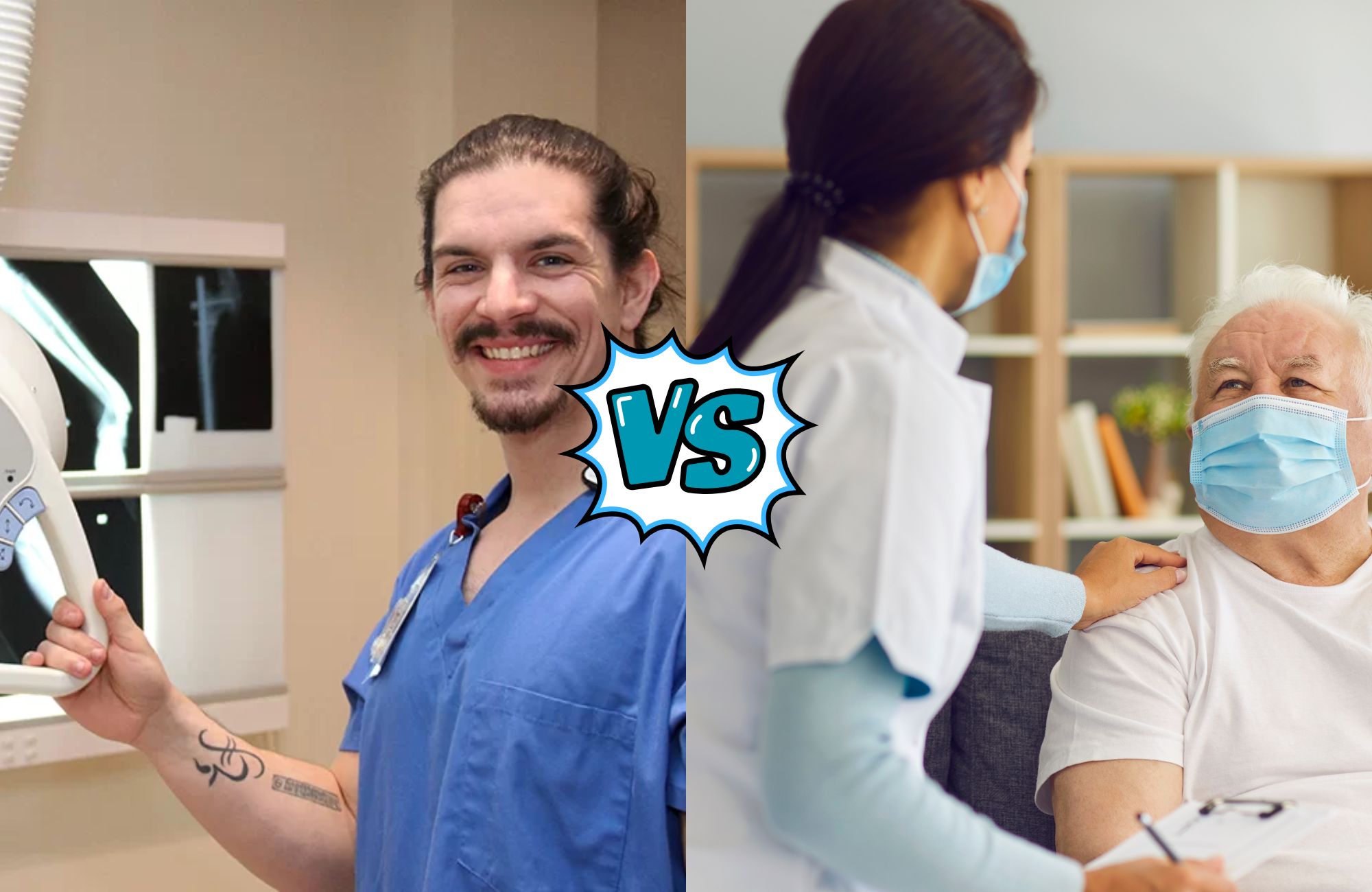


Choosing a healthcare career often comes down to understanding the differences between similar roles. Two options many people compare are rad tech vs respiratory therapist. Rad tech or radiology technicians, focus on diagnostic imaging such as X-rays, CT scans, and MRIs, while respiratory therapists specialize in treating patients with breathing problems and managing ventilators. Both careers are rewarding, but they require different skills, certifications, and daily responsibilities.
In this blog, you’ll find a clear breakdown of education requirements, job duties, salaries, career outlook, and advancement opportunities, along with guidance on which career may fit you best. You’ll also learn how Flagstar Rehab supports facilities needing reliable staffing in these areas.
Radiology technicians, also called radiologic technologists, operate imaging equipment such as X-rays, CT scanners, and MRIs. Their work helps physicians diagnose disease and injury. A typical day involves preparing and positioning patients, following safety procedures to reduce radiation exposure, and ensuring images are clear enough for interpretation. They work closely with radiologists, nurses, and other team members in hospitals, imaging centers, and outpatient facilities.
Key points:
Respiratory therapists focus on helping patients with breathing disorders. They manage ventilators, deliver oxygen therapy, and perform pulmonary function tests. RTs are also a consistent presence at the bedside, especially in intensive care units, emergency departments, and neonatal units. They not only provide immediate treatment but also educate patients with chronic conditions like COPD and asthma on how to manage their health at home.
Key points:
Both careers require formal training and certification, but the routes differ slightly. Radiology technicians typically earn an associate’s or bachelor’s degree in radiologic technology. They must pass the American Registry of Radiologic Technologists (ARRT) certification exam and, in most states, obtain a license. Respiratory therapists complete an associate’s or bachelor’s degree in respiratory care. They must pass the National Board for Respiratory Care (NBRC) exams, earning the CRT or RRT credential, and also hold a state license in nearly every state.
At a glance:
According to the U.S. Bureau of Labor Statistics, respiratory therapists earn slightly more on average than radiology technicians. In 2024, radiologic technologists and technicians reported a median salary of $77,660, while respiratory therapists reported a median salary of $80,450. Pay increases with specialization and varies by location and setting.
Factors that influence pay:
If you need experienced respiratory therapists for your hospital or clinic, connect with Flagstar Rehab. Request RT staffing support.
Both fields continue to grow, but respiratory therapy is expanding faster. Radiologic technologists and technicians are projected to see 5% growth from 2024 to 2034, while respiratory therapists are projected to grow by 12% in the same period. Aging populations and increased demand for ICU and pulmonary care are major drivers. Imaging remains steady, with consistent openings tied to hospitals, outpatient centers, and diagnostic labs.
Employment settings can also guide career planning. Hospitals remain the largest employers for both professions. Radiology technicians are also needed in outpatient imaging centers, physician offices, and diagnostic labs, which can provide more predictable schedules.
Respiratory therapists are most in demand in ICUs, ERs, and neonatal units, but they also find opportunities in long-term acute care, pulmonary rehab, and home health. These differences explain why demand for respiratory therapists has been growing faster in recent years, while demand for radiology technicians has stayed steady across multiple settings.
Specialization allows professionals in both roles to boost pay and expand opportunities. Radiology technicians may advance into CT, MRI, mammography, or interventional radiology. Some move into supervisor or PACS administrator roles. Respiratory therapists can specialize in neonatal and pediatric care, pulmonary rehabilitation, or ECMO teams, with leadership roles available for those who hold the advanced RRT credential.
Long-term growth is another factor in choosing between these two roles. Radiology technicians often expand into advanced modalities like CT, MRI, or interventional radiology, but some also move into management, teaching, or vendor training for equipment companies.
Respiratory therapists may advance into supervisory positions in ICUs, direct pulmonary rehab programs, or move into education and case management. Both fields also offer paths into academic teaching for those who complete higher degrees. These opportunities show how a career can extend beyond direct patient care and into leadership or specialized roles.
Work environments differ in pace and interaction. Radiology technicians often have shorter patient contacts focused on image quality and protocols. Respiratory therapists spend more time at the bedside, monitoring therapy and educating patients. Shift work is common in both roles, including nights and weekends in hospitals. Rad techs face physical demands like positioning patients, while RTs often handle high-pressure emergencies and ventilator management.
Ready to strengthen your respiratory care team? Flagstar Rehab connects facilities with qualified RTs across the country. Start a staffing request.
| Role | Pros | Cons |
|---|---|---|
| Radiology Technician | • Structured schedules
• Access to multiple imaging specialties • Lower stress in routine settings |
• Radiation safety concerns
• Physical effort when moving patients • Limited long-term patient relationships |
| Respiratory Therapist | • Strong demand and faster job growth
• Meaningful interactions with patients and families • Key role in critical and long-term care |
• High stress during emergencies
• Frequent night or weekend shifts • Fewer specialization tracks compared to imaging |
The following tables provide a side-by-side comparison of qualifications and requirements.
Education and credentials
| Path | Entry program | National credential | State license |
|---|---|---|---|
| Radiology technician | Associate’s or bachelor’s in radiologic technology | ARRT Radiography | Most states require it; details vary |
| Respiratory therapist | Associate’s or bachelor’s in respiratory therapy | NBRC CRT or RRT | All states except Alaska require licensure |
Salary and outlook
| Path | 2024 median pay | 2024 to 2034 growth |
|---|---|---|
| Radiologic technologists and technicians | 77,660 dollars | 4 percent subset, 5 percent overall for radiologic and MRI technologists |
| Respiratory therapists | 80,450 dollars | 12 percent |
Role focus
| Focus area | Radiology technician | Respiratory therapist |
|---|---|---|
| Patient contact time | Short and task-oriented | Ongoing and treatment-oriented |
| Technology use | X-ray, CT, MRI, PACS | Ventilators, oxygen delivery, PFTs, ABGs |
| Specialty ladders | CT, MRI, interventional, and mammography | Critical care, neonatal and pediatric, pulmonary rehab, ECMO |
Flagstar Rehab connects respiratory therapists and radiology technicians with hospitals, rehab centers, and outpatient facilities nationwide. Our team provides fast credentialing checks, flexible scheduling, and recruiter support so professionals can find assignments that match their specialty and lifestyle. Facilities benefit from reliable staffing solutions that reduce coverage gaps and maintain quality care. Whether you are a new graduate seeking your first placement or an experienced clinician looking for travel or long-term opportunities, Flagstar Rehab is focused on helping you achieve your career goals with dependable staffing services.
Both radiology technicians and respiratory therapists offer stable, rewarding careers with strong demand across the country. Radiology technicians focus on imaging and advanced technology, while respiratory therapists provide hands-on care and see faster job growth. Your choice depends on whether you prefer technical diagnostic work or continuous patient care.
Flagstar Rehab specializes in connecting healthcare facilities with experienced respiratory therapists who are ready to make an impact from day one. Our team handles credentialing, scheduling, and support so you can focus on patient care without staffing gaps. Partner with Flagstar Rehab today to secure dependable respiratory therapist staffing nationwide.
Yes. In 2024, respiratory therapists earned a median of $80,450, compared to $77,660 for radiology techs (U.S. Bureau of Labor Statistics, 2024).
No. Respiratory therapists are licensed professionals who specialize in cardiopulmonary care. They focus on breathing support, ventilator management, and patient education, while nurses provide broader general care.
Radiology technicians need ARRT certification and often a state license. Respiratory therapists need NBRC CRT or RRT credentials and a state license in nearly every state.
Respiratory therapy is projected to grow 12% through 2034, compared to 5% for radiologic technologists (BLS, 2024).